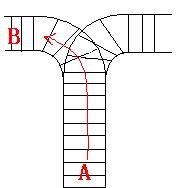


3 123 321 3 123 312
Yes. in in in out out out FINISH No. FINISHFor the first Sample Input, we let train 1 get in, then train 2 and train 3. So now train 3 is at the top of the railway, so train 3 can leave first, then train 2 and train 1. In the second Sample input, we should let train 3 leave first, so we have to let train 1 get in, then train 2 and train 3. Now we can let train 3 leave. But after that we can‘t let train 1 leave before train 2, because train 2 is at the top of the railway at the moment. So we output "No.".HintHint
栈的水题一道,就直接对进出栈进行模拟,和之前做的那道题类似,用来练练STL还是不错的,直接用STL水过。
http://blog.csdn.net/whjkm/article/details/38455291 可以看看之前的那道题;
用来vector 和 stack容器,用vector来存储字符串;
#include <cstdio>
#include <cstring>
#include <string>
#include <iostream>
#include <stack>
#include <vector>
using namespace std;
int main()
{
int n,i,j;
string str1,str2;
while(cin>>n>>str1>>str2)
{
stack<int>s;
vector<string>v;
for(i=0,j=0;i<n&&j<n;i++)
{
s.push(str1[i]);//把元素进栈
v.push_back("in");//压进vector容器
while(s.top()==str2[j])//进行匹配
{
if(!s.empty())
{
s.pop();
v.push_back("out");
}
j++;
if(s.empty()) break;
}
}
if(j==n)
{
printf("Yes.\n");
for(i=0; i< v.size();i++)
cout<< v[i] <<endl;
printf("FINISH\n");
}
else
printf("No.\nFINISH\n");
}
return 0;
}
hdu 1022 Train Problem I(栈的应用+STL),布布扣,bubuko.com
hdu 1022 Train Problem I(栈的应用+STL)
原文地址:http://blog.csdn.net/whjkm/article/details/38456533